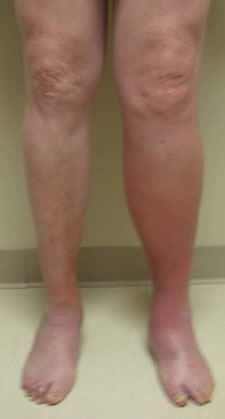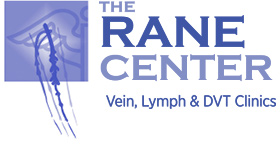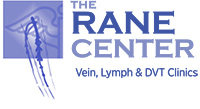 Acute Deep Venous Thrombosis (DVT) is a blood clot, or thrombus, which develops suddenly in the large veins of the legs or pelvic area. Pooling of the blood in the veins occurs any time activity of the legs is restricted and promotes forming of blood clots. DVT can run in families, but is usually caused by changes in the blood clotting mechanisms resulting from injury, surgery or other illnesses such as cancer or heart disease. One-half of people with DVT do not have any symptoms. Common symptoms, when present, are sudden leg and pain tenderness in the calf muscles, as well as swelling or a change in color on one leg to blue or purple. Symptoms can appear suddenly or develop over time. If you develop any of these symptoms, you should contact your doctor immediately. Symptoms resembling blood clot in the legs often result from other conditions that are not dangerous. An ultrasound scan of the legs can often help sort out the various diagnostic possibilities.
Acute Deep Venous Thrombosis (DVT) is a blood clot, or thrombus, which develops suddenly in the large veins of the legs or pelvic area. Pooling of the blood in the veins occurs any time activity of the legs is restricted and promotes forming of blood clots. DVT can run in families, but is usually caused by changes in the blood clotting mechanisms resulting from injury, surgery or other illnesses such as cancer or heart disease. One-half of people with DVT do not have any symptoms. Common symptoms, when present, are sudden leg and pain tenderness in the calf muscles, as well as swelling or a change in color on one leg to blue or purple. Symptoms can appear suddenly or develop over time. If you develop any of these symptoms, you should contact your doctor immediately. Symptoms resembling blood clot in the legs often result from other conditions that are not dangerous. An ultrasound scan of the legs can often help sort out the various diagnostic possibilities.
Symptoms are different when the blood clot breaks loose. The clots may travel to the lungs causing a pulmonary embolism (PE). Symptoms of PE include chest pain, shortness of breath, rapid pulse or a cough. PE is often mistaken for a heart attack and can be just as deadly.
A thorough examination of the legs by a vascular specialist using an ultrasound scan can confirm diagnosis of a clot. For most DVTs, physicians recommend immediate “blood thinning” (taking anticoagulant medications to prevent additional blood clotting or PE), wearing graduated compression stockings for at least a year, immediate ambulation and elevation of the leg at rest. In severe symptomatic cases or if the DVT is extensive, thrombolytic therapy may be recommended. These patients should be evaluated by a vascular surgeon. This therapy uses intravenous medication or mechanical devices to dissolve or remove the clots. Thrombectomy is another procedure in which the clot is extracted using catheters or surgery. Effective treatment prevents PE in more than 95% of cases.

